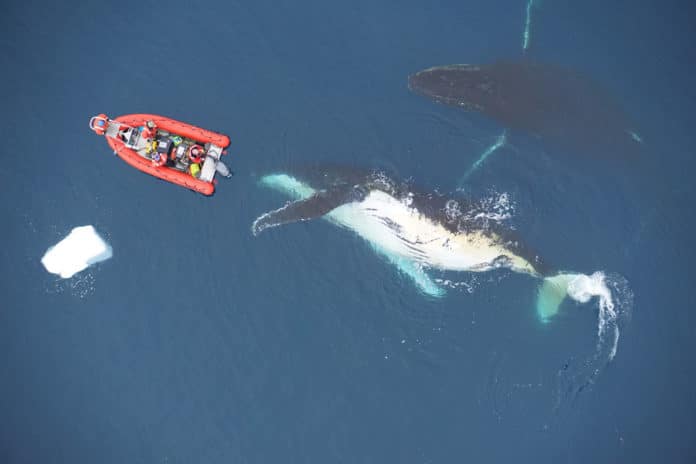Blue whales are the largest animals ever known to have lived on Earth. These magnificent marine mammals rule the oceans at up to 100 feet long and upwards of 200 tons.
Sperm whales are also one of the largest living animals. The ocean has hosted the rise and fall of giant tetrapods since the Triassic, but the largest known animals persist in today’s oceans, comprising multiple cetacean lineages.
What limits animal size has long been of interest. Since the planet’s largest living animals spend most of their time underneath the sea surface, where their behavior is challenging to monitor, thoughts regarding what impacts and constrains their size have been, for the most part, theoretical.
Now, scientists have determined how much energy species of different sizes invest to capture their prey and which of these species reap the greatest rewards for their efforts. To do so, they gathered data from hundreds of feeding whales.
The results demonstrated that the availability of their prey limits that body size in all whales, but only filter-feeding whales have evolved a feeding strategy that helps them to achieve the largest body sizes to have ever evolved on Earth.
Scientists obtained the data for their study after seeking and tagging whales, porpoises, and dolphins of various sizes—from 5-foot-long harbor porpoises to gigantic blue whales. They also tracked animals’ underwater activities using multi-sensor tags, which were temporarily affixed on animals’ backs via suction cups, reaching from their boats with long poles to stick.
Once set up, accelerometers, pressure sensors, cameras, and hydrophones in these tag devices gave information on the animal’s movements as they submerged to feed. Utilizing sonar devices in the encompassing waters and records of prey in whale stomachs, the scientists additionally assessed the density of prey in each tagged predator’s vicinity.
The obtained data was then calculated to find the energetic costs, benefits, and total payoff of foraging for each whale.
Stanford University biologist Jeremy Goldbogen said, “Energy is a critical currency for all life, and we wanted to know how energy gain compares to energy use in foraging whales with different body sizes and feeding strategies. The ratio of energy gain relative to energy use reveals a whale’s foraging efficiency, and that provides clues as to why different whales are big and why they aren’t bigger.”
What scientists found: The relationship between body size and energetic payoff, depended on what feeding strategy a whale had evolved to use—whether a whale was a filter feeder that gulps down schools of prey and strains them from ocean water in their mouth or, instead, a toothed hunter that catches prey individually.
Blue whales, humpbacks, and other filter-feeding whales use baleen—rows of flexible hair-like plates in their mouths—to strain krill and other small prey from ocean water. They seek out dense patches of their prey and almost always, the data showed, consume more calories than they expend when they feed. For filter-feeding whales, the large size does not impede to foraging: blue whales, fin whales, and humpback whales, the largest whales in this study, achieved greater energy payoff during feeding events than any other whale in the study.
Nicholas Pyenson, curator of fossil marine mammals at the Smithsonian’s National Museum of Natural History, said, “Toothed whales, instead, use echolocation to forage and are limited to feeding on one prey target at a time. They must also dive deeper than other whales to find the largest and most abundant prey, like deep-sea squid and fish. Few other warm-blooded predators can access the parts of the ocean where large toothed whales feed. Below 1,000 feet, there’s nothing else down there except all the squid you can eat.”
“But squid must be chased, and that, the data showed, takes a lot of energy—especially for the biggest toothed whales. In some cases, the largest toothed whales did not eat enough food during a dive to make up for the energy they spent getting there. They literally can’t eat enough to achieve a higher energetic payoff before they have to return to the surface and breathe.”
Sperm whales, which can be up to 60 feet long, are not only larger than any other of today’s toothed whales but are also bigger than all of their fossil ancestors. That makes sense because, based on the relative energy efficiencies that the team calculated for different-sized toothed whales, being a sperm whale today is pushing a severe biological limit.”
The team’s calculations reveal that the sperm whales would not have the option to discover enough of the largest squid prey to maintain their body size if they were any bigger—there are insufficient large squid to sustain bigger sperm whales.
On the other hand, large filter-feeding whales are not restricted in their body size by the accessibility of their prey, similarly toothed whales. Filter-feeding whales feed on little yet plentiful krill prey that flourishes at high populace densities for short timeframes in specific parts of the world.
Thus, scientists guess that the seasonal accessibility of their plentiful prey is the thing that eventually constrains size in today’s filter-feeding ocean giants mammoths like fin whales and blue whales.
Goldbogen said, “The largest baleen whale species must reap the energy gains of krill patches in only a few of the most productive summer months at high latitudes. Highly efficient filter-feeding strategies mean that these whales can build up fat stores that can then power their migrations across ocean basins to breeding grounds at lower latitudes that are leaner and provide much less food.”
